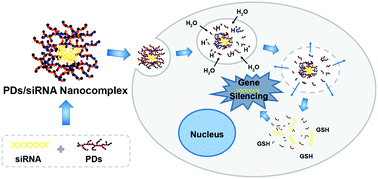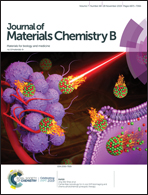Bioreducible and acid-labile polydiethylenetriamines with sequential degradability for efficient transgelin-2 siRNA delivery†
Abstract
The transgelin-2 (TAGLN2) protein plays an important role in multidrug resistance in human breast cancer. siRNA mediated gene silencing of TAGLN2 is a promising strategy for paclitaxel resistance reversal in breast cancer. In this study, a series of bioreducible and acid-labile polydiethylenetriamines (PDs) with different proportions of cross-linkers were synthesized. TAGLN2 siRNA was condensed by PDs to form dual-responsive nanocomplexes, and these nanocomplexes were hypothesized to partially degrade in the acidic environment of endosomes, and then completely degrade in the reducing environment of the cytoplasm to release siRNA. It was found that PDs have good water solubility, acid–base buffering capacity, suitable degradability and high biocompatibility. Moreover, PDCKM can deliver TAGLN2 siRNA into MCF-7/PTX cells and inhibit the expression of TAGLN2 even better than PEI 25k. Besides, paclitaxel showed higher cytotoxicity in cells incubated with PDCKM/TAGLN2 siRNA nanocomplexes. These results suggested that PDs have great potential for safe and efficient siRNA delivery to reverse paclitaxel resistance in breast cancer.



 Please wait while we load your content...
Please wait while we load your content...